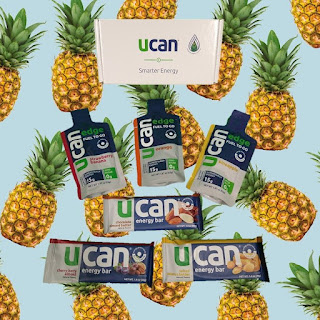"Disclaimer: I received a variety of UCAN Edge Energy gels and bars to review as part of being a BibRave Ambassador. Learn more about becoming a BibRave Ambassador, and check out BibRave.com to review, find, and write race reviews!"
Sugar Free Energy!? Say What? I Can and UCAN Too!
Usually when I see “sugar free” used to advertise any type of endurance sport energy supplement, it’s a turn off for me. I associate “sugar free” with low calorie, which is a negative characteristic in my opinion when selecting fuel sources for long efforts. I look for calorie dense foods that can be easily packed in my hydration vest and consumed on the move. Calorie dense means more calories in less volume and less to carry to fuel my long runs. So when I learned of UCAN sugar free Edge Energy gels I was a bit skeptical. But once I overcame my bias against sugar free fuels, read the nutrition label on the gel packet, and gave them an honest try, I became a fan.
Each Edge Energy gel packet contains 70 calories. This is only slightly less than most other energy gel brands I have tried which have ranged from around 90-120 calories per packet. So not a deal breaker at all. For me, it would just mean adjusting the timing of how frequently I eat a gel during a long run. I usually consume one gel every hour or so. Using UCAN Edge Energy gels would just mean I’m a bit more strict about not going beyond that “one gel per hour” schedule.
The taste of the gels was different from other sugary gels I’ve tried. UCAN Edge Energy gels were certainly less sweet and it felt more like I was consuming some type of actual food. These are both positive traits, in my opinion. I’m always very turned off by overly sweet drinks and foods during long runs. It was nice to feel like I was consuming actual food rather than a packet of syrup.
I was similarly impressed by the UCAN energy bars. Again, not overly sweet, sticky messes being marketed as sports nutrition. The bars were tasty, soft, and easy to eat on the go, fueling the longest test run I did with them (22 miles) without any stomach issues or energy crashes.
As I approach the end of my training block for Big’s Backyard (only a little over a month away now), I’ve been pretty certain my nutrition plan is dialed in and set. However, testing out these UCAN Edge Energy gels and bars has made me question if there’s room for improvement. I believe UCAN products could be another valuable tool in my nutrition tool box while I run at Big’s. I will definitely be bringing some UCAN products with me to Big’s because who knows, it could be what saves my race and keeps me going on day two, three, or even four?
Scott Snell
9 September 2022
See what my fellow BibRavePros thought:
Want to try them yourself? Use discount code: BIBRAVE25 - 25% off, no bundles or subscriptions, good thru 10/9/2022










































